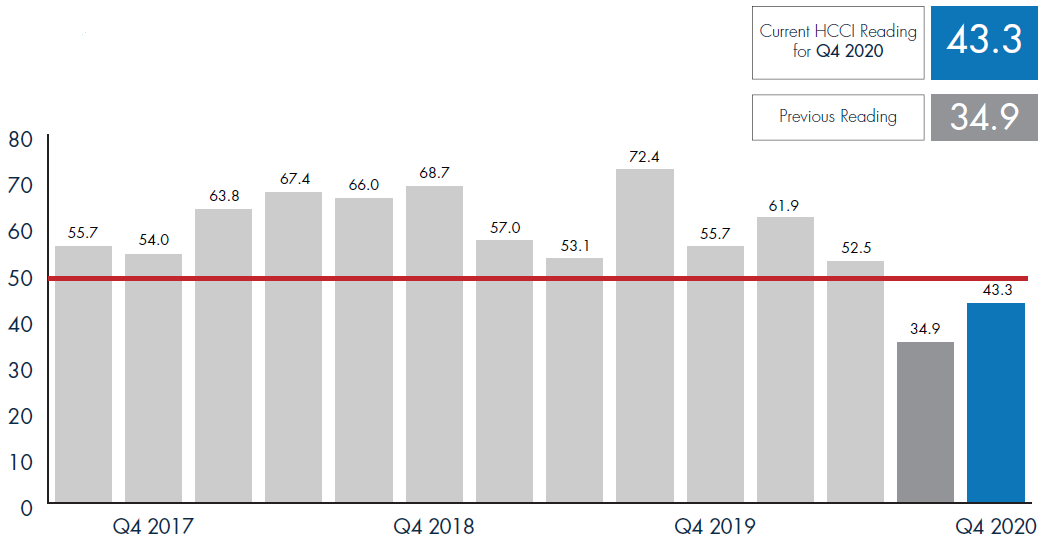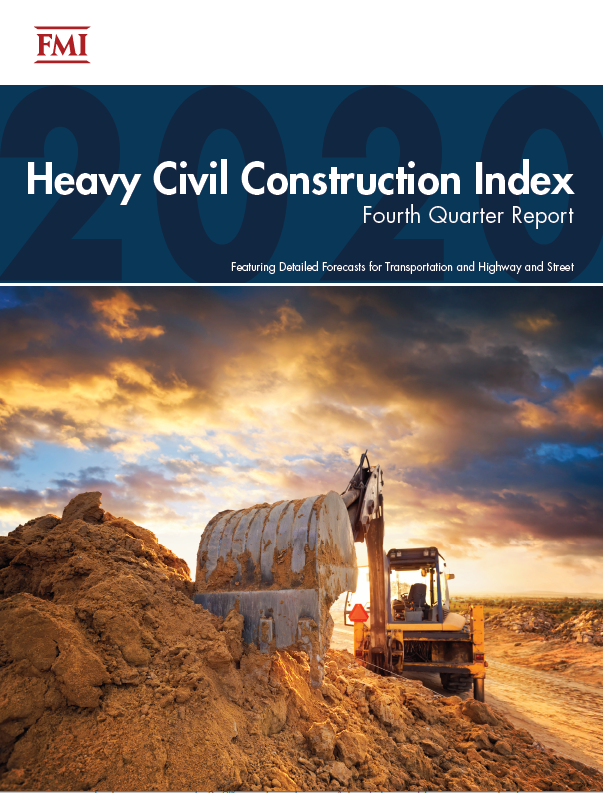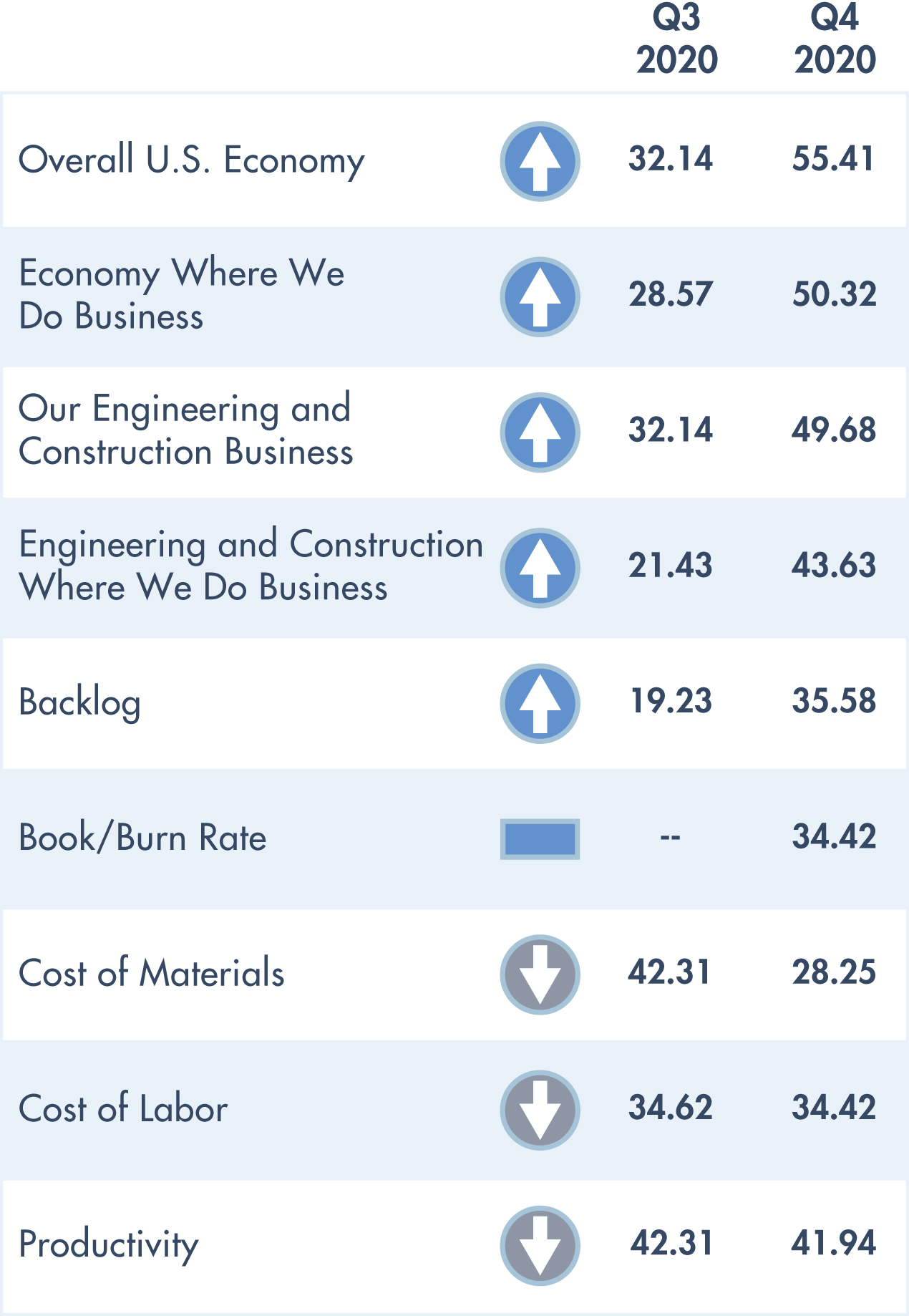2020 Heavy Civil Construction Index: Fourth Quarter Report
The fourth quarter 2020 Heavy Civil Construction Index (HCCI) increased from 34.9 to 43.3, buoyed by a positive outlook on the economy and increasing confidence in the construction industry. Materials, labor and productivity measures all remain depressed. The trends seen in the index are reflective of cautious optimism toward next year, especially when compared to the economic fallout experienced through the first half of this year.
Continued relaxing of social distancing requirements, significant government stimulus and growing economic confidence have all contributed to improved expectations. Across heavy civil segments, residential site development and private utilities carry the most optimism for next quarter, contrasted by weak expectations for transit/rail, aviation and commercial site development.
Nearly half (48 percent) of survey respondents are burning backlog faster than it is being replaced on a year-over-year basis. Within the past six months, approximately one-third (34 percent) have found new, nontraditional competitors on bids, and within the past quarter, more than half of respondents have recognized increased competition (53 percent) alongside lower bid prices (56 percent).
As illustrated on pages 8 and 9 of the report, this quarter’s survey assessed the potential impact, both positive and negative, across a variety of factors affecting U.S. economic and business conditions in 2021. November election results were the most commonly selected positive factor, followed by private sector investment, U.S. federal budget and U.S./world health issues, vaccines or pandemics.
Conversely, U.S./world health issues, vaccines or pandemics and the results of the U.S. presidential and congressional elections tied as the most commonly selected negative factors expected to affect U.S. economic and business conditions in 2021.
FMI’s third quarter 2020 heavy civil forecast for combined transportation and highway and street construction indicates 2020 spending levels 1.4 percent higher than 2019 spending levels.
Growth through 2020 will be led by water (16 percent) and bolstered by stability in rail/transit (4 percent) and roadway spending (3 percent). Declines in 2020 are anticipated for air (4.5 percent) and bridge spending (3 percent).
HCCI scores are based on a diffusion index where scores above 50 represent improving or expanding industry conditions, a score of 50 represents conditions remaining the same, and a score below 50 represents worse conditions than last quarter (or contraction).
HEAVY CIVIL CONSTRUCTION INDEX (HCCI) Q3 2017 TO Q4 2020

To access the full report including all charts and graphs, please click below to download.
 Brian Moore is a principal and strategy practice leader with FMI. Brian focuses on consulting with contractors on various strategic, organizational and operational issues. Brian works in identifying future construction trends, market conditions and competitive issues that impact strategic decisions. Brian’s clients count on him as a thought leader and trusted advisor as they plan the future of their business. He works with clients to help them develop the organizational capabilities that match their chosen strategy so they can achieve desired results. Brian can be reached at [email protected].
Brian Moore is a principal and strategy practice leader with FMI. Brian focuses on consulting with contractors on various strategic, organizational and operational issues. Brian works in identifying future construction trends, market conditions and competitive issues that impact strategic decisions. Brian’s clients count on him as a thought leader and trusted advisor as they plan the future of their business. He works with clients to help them develop the organizational capabilities that match their chosen strategy so they can achieve desired results. Brian can be reached at [email protected]. Paul Trombitas is a senior consultant with FMI’s strategy practice and works with clients across the engineering and construction industry. He is responsible for managing and delivering in-depth market insights focused on the Built Environment. He is actively involved with clients in developing market strategy, focusing on alternative project delivery methods. Paul has been quoted in multiple publications, including ENR, regarding the design-build market and maintains key stakeholder relationships that provide unparalleled industry access. Paul can be reached at [email protected].
Paul Trombitas is a senior consultant with FMI’s strategy practice and works with clients across the engineering and construction industry. He is responsible for managing and delivering in-depth market insights focused on the Built Environment. He is actively involved with clients in developing market strategy, focusing on alternative project delivery methods. Paul has been quoted in multiple publications, including ENR, regarding the design-build market and maintains key stakeholder relationships that provide unparalleled industry access. Paul can be reached at [email protected]. Brian Strawberry is a senior economist with FMI. Brian’s expertise is in economic and statistical modeling. He leads FMI’s efforts in market sizing, forecasting, and building product/construction material pricing and consumption trends. The combination of Brian’s analytical skills and creative problem-solving abilities has proven valuable for many contractors, owners and private equity groups as well as industry associations and internal research initiatives. Brian can be reached at [email protected].
Brian Strawberry is a senior economist with FMI. Brian’s expertise is in economic and statistical modeling. He leads FMI’s efforts in market sizing, forecasting, and building product/construction material pricing and consumption trends. The combination of Brian’s analytical skills and creative problem-solving abilities has proven valuable for many contractors, owners and private equity groups as well as industry associations and internal research initiatives. Brian can be reached at [email protected]. Emily Beardall is a senior analyst for FMI’s strategy practice. Emily is responsible for creating and developing tools to deliver innovative solutions for our clients. She is committed to utilizing these strategic tools to improve company performance and profitability. Emily can be reached at [email protected].
Emily Beardall is a senior analyst for FMI’s strategy practice. Emily is responsible for creating and developing tools to deliver innovative solutions for our clients. She is committed to utilizing these strategic tools to improve company performance and profitability. Emily can be reached at [email protected].

